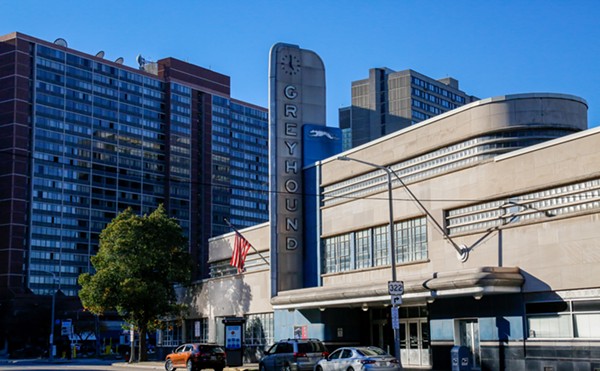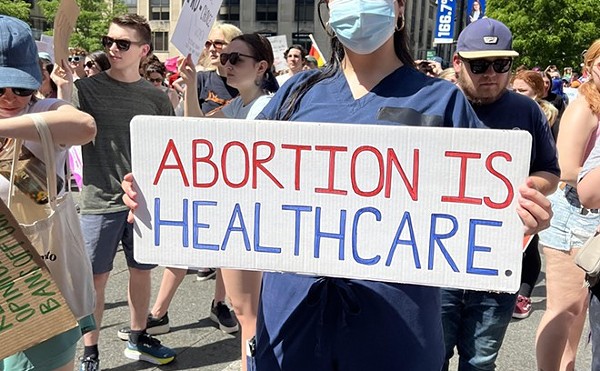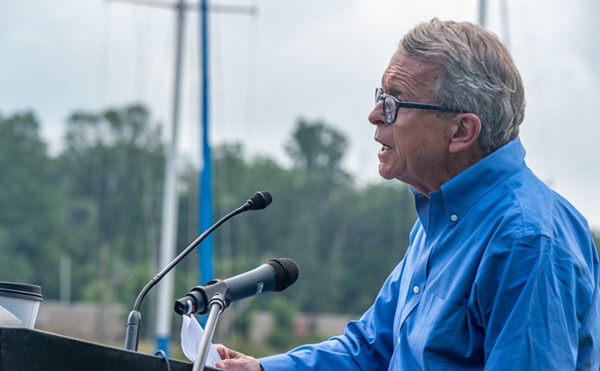"I'm here for my grandchildren — for their self-esteem," says Marjorie Villafane, a Sioux from North Dakota who has lived in Cleveland for more than 40 years and has participated in the annual Opening Day protest of Chief Wahoo for the last 20.
"I'm here so my grandchildren can be proud of their heritage. People act like we're trying to take their baseball away from them, but we're not. It's just, why do they have to turn us into Chief Wahoo?"
Jim Farrar, a member of the Cherokee Nation who drove from Michigan to join this year's demonstration, speaks of re-education camps and smallpox-infested blankets — painful memories associated with the displacement of indigenous North Americans by European colonists. To Farrar and many protesters, Wahoo's exaggerated features and toothsome grin trivialize and mock their history.
"It isn't guilt that we want you to feel," he says. "Just understand what our opposition comes from."
In 1991, the Committee of 500 Years of Dignity and Resistance was formed in response to the celebration of the 500th anniversary of Christopher Columbus' arrival in the Western Hemisphere. Its purpose was to educate the public on "the truth about Columbus" from the perspective of Native Americans. Today, the Cleveland-based organization's focus is decidedly more narrow: They're committed to seeing Cleveland's Major League Baseball club drop the use of Chief Wahoo and its 97-year-old nickname.
It's not the most visible of movements, and it seeps into the public consciousness only for one afternoon each year. This time, a group of about 20 took part in the protest, marching outside Progressive Field and bellowing slogans like "Enjoy the Game, Change the Logo." Some placed pieces of Easter candy where arriving fans could find them; attached to each marshmallow Peep was one in a series of fortune-cookie messages: "Would Jesus Wear Wahoo?" "People, Not Mascots." "The Louis Sockalexis Myth Is a Lie."
The ballclub — and most of its fans — is not hearing any of it.
"I love Chief Wahoo," Diane McMaster-Murphy exclaims, smacking a Peep off the post where a protester had placed it. "I'm an American," adds the 57-year old white lady from Akron, adding a twist of patriotism to an otherwise indiscernible molecule of logic.
Six and a half decades after its creation, the Chief remains the only professional sports logo in the Western world that caricaturizes a race of people. But in the land of Wahoo, no reason is still reason enough.
***
To many if not most Clevelanders, Chief Wahoo has never represented a race of people at all, but a benevolent symbol of the magic of those first trips to the ballpark: a smiling, slugging alien angel of joy. Given these positive associations, many find it especially easy to ignore that Wahoo was created in an era when popular attitudes toward minorities were quite different than they are today.
The symbol first appeared in 1947, the creation of Walter Goldbach, a 17-year-old draftsman hired by Indians owner Bill Veeck to design a mascot that "would convey a spirit of pure joy and unbridled enthusiasm." Goldbach's version had yellow skin and a phallically prominent nose. By 1951, the figure made its debut on Indians uniforms, updated with fire-engine-red skin and a more giddy, less imbecilic grin. Sportswriters provided the name "Chief Wahoo."
Goldbach has said that he had a hard time "figuring out how to make an Indian look like a cartoon.
"It was the last thing on my mind that I would offend someone," he added.
But to Dr. David Pilgrim, an expert in racial imagery, the symbol is a "red Sambo" that hardly differs from the caricatures of blacks popular in the Jim Crow era in which Wahoo was created — a time when such depictions of minority races were popularly used to inflame prejudice and justify discriminatory laws and behavior.
A sociology professor at Ferris State University in Michigan, Pilgrim is also the founder and curator of the school's Jim Crow Museum of Racist Memorabilia. There, an astonishing 7,000 piece (and growing) collection of artifacts depicts the history of racist portrayals of minorities in American popular culture.
"These were caricatures with a purpose: to legitimize patterns of prejudice, discrimination, and segregation," says Pilgrim. "These caricatures don't just exist to exist; they both reflect and shape attitudes toward a group."













